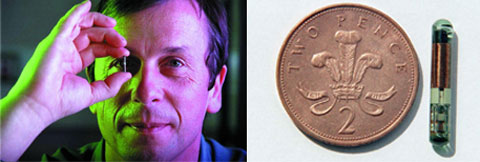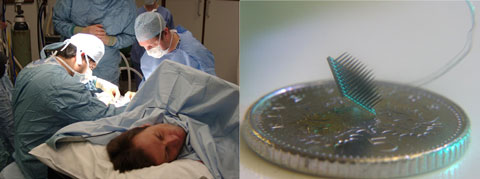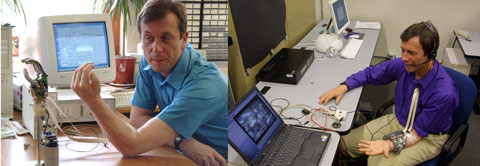The Cyborg Scientist
Much of the physical world remains invisible to our traditional senses: We must use machines to see ultraviolet light, view infrared radiation, or detect magnetic fields. But “Project Cyborg,” — a research project that has led its brainchild to have implants surgically inserted into his arm — aims to blur the lines between human and machine.
Extending Senses
Extending our senses is nothing new. Magnifying glasses and microscopes have revealed a tiny world teeming with activity invisible to the naked eye. Telescopes help us see things that are too far away to see with our own eyes. Microphones, speakers, and amplifiers help us hear things that are too quiet to detect with our ears. People can certainly detect and measure electromagnetic fields, but this requires instruments outside the person, which then interacts with the person’s senses.
So what’s new with “Project Cyborg”? Implanting a device inside a human, so the device can interact with the human nervous system and brain directly.
Professor Kevin Warwick, University of Reading in the United Kingdom, creates, studies and tries these devices. He even has implants already! In 1998, Professor Warwick began the first phase of what is known as “Project Cyborg”.1 To test out implants, he had an electronic transponder chip implanted in his arm . A transponder is a wireless device that will send out a set of information based on the question it receives.

The photograph on the left is of Professor Warwick holding the transponder, and the right image is a close up of the transponder. Image Credit: The University of Reading.
For example, highway toll booths use this method for fast pass lanes. As you drive through the special toll booth, a computer sends out a query for your name and the account to charge the toll to. The transponder chip, perhaps on a sticker on your car window, sends out your name and your account information. Transponders can also resend a set of information received.
Professor Warwick’s transponder chip allowed the computers in his work building to directly gather information from his chip. When he came near the building, doors would open, lights would turn on, and the speaker system in the building would sound out a greeting to him. The transponder chip was not rejected by his body, signaling a successful first stage of the project.
Phase Two
In 2002, Dr. Warwick started the second phase of his “Project Cyborg” having a new transponder implanted and a neuronal implant. The neuronal implant was a chip with a 4x4 mm array containing one hundred, 1.5 mm long electrodes that went directly into the median nerve of his left forearm.2 The chip was also connected to a connector pad.

The photograph on the left is of Professor Warwick during surgery implanting the array chip shown on the left. Image Credit: The University of Reading
The connector pad could be hardwired to a computer or connect wirelessly with a digital radio transmitter.2 In this way, Professor Warwick could use his nervous system to link his brain and hand movements to the computer. The neuronal implant was able to send electrical impulses to Professor Warwick’s nervous system, and receive electrical impulses from his nervous system.
The electrical impulses he sent to the array had to be mapped out so that the information could be utilized. For example, when Professor Warwick moved one of the fingers on his left hand, a unique type of electrical impulse was received by the neuronal implant.
By knowing this unique impulse, they could use it as a command to control a device. Similarly, when an external factor sent an electrical impulse through the neuronal implant to his nervous system and brain, Warwick had to figure out what that signal was.2
Chip Control
After six weeks of electric pulses and practice, Professor Warwick was able to use this chip hooked to an ultrasonic detector to determine when objects were getting closer or further away. He could detect the frequency change with his brain when these impulses entered into his nervous system.
He also learned to control a robotic hand using movements of his own hand and receiving a feedback signal from the robotic hand directly into his median nerve. He not only controlled the robot hand wirelessly but also controlled it from overseas via the Internet! While visiting NY, he connected the chip in his median nerve to a computer and sent his brain waves through the Internet to the robotic hand in his lab in England. In turn, he received feedback from the robotic hand through the Internet to his brain!

Photos of Professor Warwick controlling a robotic hand, and Prof. Warwick in NY controlling a robotic hand in England by sending his brain waves through the Internet. Image Credit: The University of Reading
Using this same technology, Professor Warwick controlled an electric wheelchair with only hand movements. Within a few hours, he learned to control the speed, turning, and stopping of the chair.
He also had direct brain-to-brain (or nervous system to nervous system) communication with his wife by connecting a chip to her nervous system and hardwiring their nervous systems together. When his wife moved her hand, he received an electrical impulse into his nervous system through the chip in his arm. His nervous system was directly receiving information from her nervous system, and he felt this in his brain in the same way he felt other electrical impulses he had received from the neuronal implant.
A Magnetic Connection
Professor Warwick’s students have implanted small magnets, the size of sesame seeds, into their fingertips. These magnets interact with other magnetic fields, and can cause a vibrating sensation in the magnet-bearing fingers. This is not a direct signal into the nervous system, like the array chip Professor Warwick had implanted into his median nerve. Rather, the movement of the magnet stimulates the nerves in the fingertip.
The magnetic force between two magnetic fields increases as the strength of the magnets increases and as the distance between the two magnets decreases. However, the vibrating sensation the students experience is most likely due to a changing magnetic field.
A fixed magnetic field gives a constant pull on the magnet inside the finger. Similarly, magnetic compasses get pulled to align themselves with Earth’s magnetic field before resting in place. When a magnetic compass interacts with a changing magnetic field, you can see the compass needle spin around rapidly.
Magnetic fields are created by moving charges. Some atoms have their electrons lined up in such a way that create an overall magnetic field. Magnets like the one attached to your fridge are composed of a bunch of such atoms aligned in the right way. Electrical current — or just moving charges — produce magnetic fields, allowing the implants to detect electronic devices.
As an example, consider the magnet (the needle) in a magnetic compass pointing toward Earth’s North Pole. The compass’ magnetic strength is much weaker than the implant but follows the same physical laws.
When another magnet is brought nearby (say from the west), it changes the direction of the magnetic compass needle. Moving around the magnet gives a pronounced movement of the compass needle. The effect of electronic devices, such as cell phones, on the compass needle is also shown in the video below.
More importantly, just about everything we can measure can be transformed into an electrical signal — sound, light, temperature, distance, speed. These magnetic implants can be used to measure a number of things, if they are coupled to other sensors.
Professor Warwick’s students, in 20108, hooked up ultrasonic or infrared detectors, worn on a hat, and connected the circuitry to a metallic ring that can be worn around the finger with the magnetic implant. Using the ultrasonic detectors, radio waves or sound waves are sent out and received by the electronic sensor.
As the sensor gets closer to an object it receives waves at a higher rate (increased frequency), and as the sensor gets further from an object, the frequency decreases. The overall delay time between the wave sent and received gives information about the location of the object. The implantee feels a vibration in her/his finger with the magnetic implant. As an object gets closer, the vibration in the finger increases. Moving the object further away decreases the vibration.
For temperature detection, one can place circuitry with infrared sensors on a cap and detect temperature differences between objects. These detections are then converted to an electrical signal and felt as a change in the vibration of the implant in the finger.
Again, this magnetic implant does not lead to information being directly input into one’s nervous system and processed by the brain. The array chip implanted into the median nerve requires the brain to learn what the electrical pulses it is receiving mean, process them, and send back a response stimulus. The magnetic implants provide extra input into the sense of touch, extending our senses much like a microscope enhances the use of our eyes.
To learn more about the research being done by Professor Warwick and his students, click on the TEDx video below.
Future Research
Transponder implants might be used in the future for whatever information you might want to share, such as passport information, credit cards, and medical records. However, care would have to be given to ensure that the data could not be changed or stolen. Continuous discussion goes on about “chipping” children due to fears of kidnapping amidst privacy concerns. This technology has become popular with pet owners.
The idea of using an array chip implant has many applications for people who have lost mobility and may need prosthetics (neuroprosthetics), wheelchairs, or other devices to assist their quality of life.
The magnetic implants or chip arrays may also have many applications in new ways making physical measurements using sensory enhancements.
References and Resources
1. 1) Professor Kevin Warwick’s website at the University of Reading, United Kingdom
http://www.reading.ac.uk/sse/about/staff/k-warwick.aspx
http://www.kevinwarwick.com/
2. Warwick, K. et al., The Application of Implant Technology for Cybernetic Systems, Arch. Neurol. (60) pp 1369-1373, Oct 2003
3. Warwick, K. et al., An Attempt to Extend Human Sensory Capabilities by Means of Implant Technology, IEEE Conference, Man and Cybernetics, HI pp. 1663-1668, Oct 2005
4. Shapiro, A.D., “Engineering Extra Senses,” PBS NOVA Science Now, 8 November 2012
PBS Video
5. Norton, Q. A Sixth Sense for a Wired World, Wired Magazine, 7 June 2006
http://www.wired.com/gadgets/mods/news/2006/06/71087?currentPage=all
6. TEDx talk with Kevin Warwick
http://www.youtube.com/watch?v=Z8HeFNJjuj0
7. Robot with Rat Brain, YouTube
http://www.youtube.com/watch?v=1-0eZytv6Qk
8. Hammed, J., A novel human-machine interface using subdermal magnetic implants, 2010 IEEE 9th International Conference on Cybernetic Intelligent Systems (CIS).
IEEE Link
—Heide Doss














